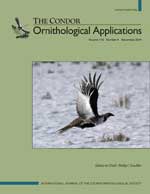BioOne.org will be down briefly for maintenance on 14 May 2025 between 18:00-22:00 Pacific Time US. We apologize for any inconvenience.
Articles (3)
RESEARCH ARTICLES (11)
COMMENTARY (1)

No abstract available
No abstract available
No abstract available
No abstract available
Factors influencing nest survival and productivity of Red-throated Loons ( Gavia stellata) in Alaska
No abstract available
